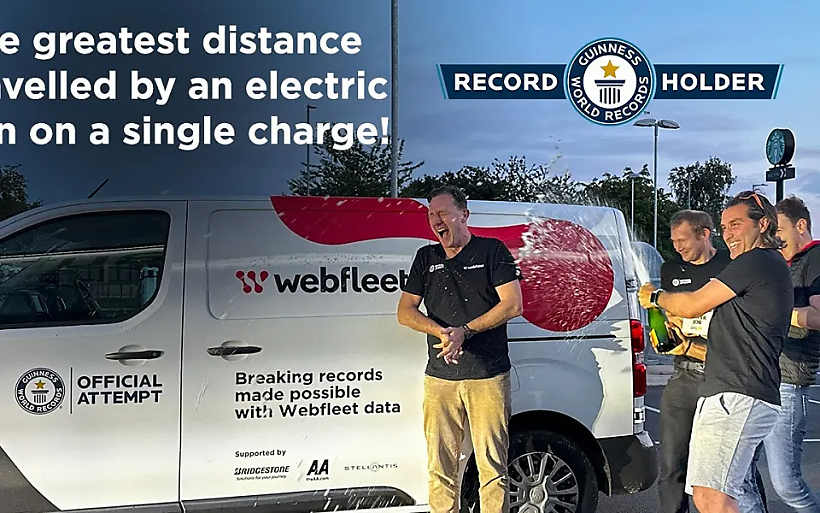Webfleet is the official Guinness World Records holder for “The greatest distance travelled by an electric van on a single charge”. The team achieved 311.18 miles (500.8 kilometres) from a Fiat E-Scudo with a 75 kWh battery and a WLTP of 205 miles. This article will provide 8 essential tips to improve efficiency and boost your electric van range.
Are you considering a transition to an electric van fleet? Or are you seeking ways to enhance efficiency? Regardless of where you are on your journey or the capacity of your electric van battery, rest assured that we can help you overcome electric range concerns and make the most of your current resources.
1. Pre-journey Preparations: Preheat or cool your electric van
Operating in extreme conditions (hot or cold) already harms your electric van range. Introducing amenities such as air conditioning and heated seats only amplifies battery reduction. Therefore, electric van drivers need to plan their usage to ensure sufficient remaining battery to complete the job.
By programming your electric vans to preheat or cool the cabin whilst the vehicle is still on charge, either at the depot or a public charging station, you can preserve the battery for the journey ahead. Programming ahead removes any inconvenience for the driver, who would otherwise have to operate the van in harsh cold or hot conditions.
2. Plan your journey and electric van range
Route planning before beginning a journey is essential to efficiently operating an electric van. The Guinness World Record route took extensive planning to maximise the range of the electric van. The availability of charging stations, traffic conditions and elevation were all factored into the planning. Whilst the average driver is not undertaking a record attempt. The message still stands, that effective planning ahead of time will reduce the likelihood of issues. Take into consideration the availability of charging stations, planned breaks and miles remaining to complete the journey.
A change in mentality towards charging is also a pivotal way to plan effectively. The general consensus is to charge when you need to i.e. when your remaining battery isn’t sufficient for the remaining distance. However, drivers should take on the mantra ‘Charge when you stop, don’t stop to charge’. By ‘topping up’ the battery by charging when it is convenient e.g. a lunch break, the driver can ensure they have more than sufficient battery to complete the journey.
3. Master the art of regenerative breaking
Electric vehicles utilise kinetic energy in the wheels via regenerative braking to add more miles to the range. The typically wasted kinetic energy is regenerated during deceleration, converting it into electrical power that replenishes the battery. To maximise regen in the electric van the driver is required to preempt stopping and manage the accelerator to slowly bring the vehicle to a halt. The earlier the driver starts to slowly manage the accelerator the more regen will take place.
Depending on the electric van manufacturer, there are different modes for regenerative braking. Typically there are two modes depending on the strength of the regen. As regenerative braking increases drag, a driver would use the lowest setting on motorways as less braking is required. Whereas driving in the city with stop-start driving, it is more beneficial to use the strongest setting. Ultimately, regenerative breaking provides you will free energy that will increase your range! Therefore, it is worth using this feature whenever possible when operating an electric van.

4. Ensure optimal performance with the right tyres
To ensure maximum efficiency, the Guinness World Records electric van was fitted with EV-ready Bridgestone Duravis Van tyres featuring ground-breaking ENLITEN Technology. The tyre selection was a contributing factor to help the drivers reach the 311.18-mile distance. Moreover, this real-world application emphasises the importance of the correct tyres on an electric vehicle. When choosing tyres for your electric van it is vital to look for A-rated tires that provide minimised rolling resistance. Tyres that have high rolling resistance will cause enhance drag negatively impacting the electric van’s battery range.
Additionally, once the correct tyres are selected it is vital to maintain the correct tyre pressure. An electric van with low tyre pressure will increase drag and reduce the overall range. It is recommended to check the tyre pressure at the start of the day before beginning any journey.
5. Plan the electric van load
Electric vans are a game changer! But remember, vehicle range can be affected by certain payloads. So, it’s crucial to adjust accordingly. If a driver is carrying heavy loads, then they need to calculate the effect on the miles to the destination. A driver can also plan by removing any unnecessary load from the electric van. For example, an engineer might take all his tools to a job but only need 50% of them to complete the job effectively. Therefore, by planning ahead, the excess tools that are not needed for the job can be removed, reducing the load on the electric van and increasing range.
If a driver is carrying a heavy load, it is advised to make an additional stop at a charging station or wait to charge a few extra percentage points on the battery. This minor tweak can massively enhance the electric van’s efficiency. It’s all about managing the vehicle battery wisely to optimise your range. These small steps will save you so much time in the long run.
6. Master the art of smooth driving
Smooth driving was a key element to the success of the Guinness World Records attempt. The Webfleet-sponsored drivers used smooth driving to maximise the electric van’s 75 kWh (68 kWh useable) battery and overachieve the 205-mile WLTP by 100 miles! Here are three insightful tips to become a master in smooth driving:
- Finding the electric vans’ optimal efficient speed – Firstly, similar to internal combustion engines (ICE), higher speeds demand increased energy to overcome air resistance. Therefore, drivers need to factor in the arrival time whilst balancing the efficiency of the electric van. The Guinness World Records drivers drove just under the road speed limit on the route to reflect real-world road speeds.
- Anticipating the road ahead – Secondly, harsh acceleration and braking have a detrimental effect on the electric van range. Therefore, when approaching junctions or traffic, anticipate the road ahead and manage the accelerator to have a smooth and consistent speed.
- Select the correct driving mode – Finally, your electric van/ vans may have different driver settings from Normal, to Power and Eco. When trying to maximise the vehicle range, select the Eco driving mode. Depending on the electric van, using the Eco setting can restrict acceleration, the use of air conditioning and increase battery regeneration through braking.
7. Electric van charging
Maximising the electric van range is crucial for efficient operations. A full charge can significantly extend your vehicle’s miles, providing peace of mind if there are limited charging facilities on the route. Therefore, the driver/ fleet manager needs to plan changing cycles depending on the route for the day/week. If a driver needs the maximum range, it is best to use A/C charging for the electric van overnight to avoid peak charging prices.
If overnight charging is not possible, then plan charging stops into the route to top up the range. To make efficient charging stops during the day ensure you factor in the charging curve which reduces battery degradation. The electric van takes the same time to charge from 20% – 80% battery as it does from 80% – 100% battery. Therefore, instead of charging the electric van past 80%, it is more time-effective to factor in two shorter charging stops to top up the range to the 80% mark. The driver will also need to consider when are the peak charging times and factor this into their daily schedule.
Finally, be prepared to adapt. The Guinness World Records drivers experienced this when discovering the 7 kWh charger only produced 2.5 kWh at the hotel. This would have drastically increased their charge time. There could have been a number of factors that could have caused this, but as charging infrastructure is still in development, it is something to still be wary of. The team decided to move to a faster charging station and the rest is history! One extra tip: Be vigilant on the power output which is usually located on the charging station or the vehicle dashboard may provide a remaining charging time.
8. Utilise electric vehicle fleet management software
Utilising fleet management software that caters for electric vans, means fleets can compare the kWh per mile efficiency of their vans and drivers. Driving performance monitoring solutions, such as Webfleet’s OptiDrive 360 scores and profiles drivers based on key performance indicators e.g. harsh steering and braking. Having detailed insights into driving behaviour allows drivers to improve their driving skills with real-time feedback. Ultimately, providing a smoother driving experience and increasing the range capabilities of the electric vans.
Moreover, solutions such as Webfleet’s EV toolkit provide vital insights for smoother electric van adoption and improved efficiency. Valuable tools like planning reports grant visibility into drivers’ miles travelled and routes. Subsequently, this data aids in identifying vans which would be more cost-effective and efficient to switch to electric alternatives.
Guinness World Records holders

Webfleet-sponsored drivers Kevin Booker, Sam Clarke, and Fergal McGrath accomplished a groundbreaking achievement using a FIAT E-Scudo. Verified Webfleet data, including video footage, odometer, GPS, and battery levels, showcased the remarkable performance of the compact van: achieving an average of 4.5 miles per kilowatt hour (kWh) with its 75 kWh battery and 205-mile WLTP range. Watch how the drivers broke the previous record of 258 miles (held by FedEx) with an astonishing 311.18 miles on a single charge!
Transitioning to an electric fleet?
Are you seeking the ideal telematics partner to support your electric vehicle requirements? Webfleet offers cutting-edge software tailored for effective electric vehicle fleet management. Enhance charge cycles, reduce expenses, boost productivity and maximise return on investment (ROI). Dive into our array of electric vehicle solutions by arranging a free consultation with Webfleet’s team of dedicated EV specialists.








